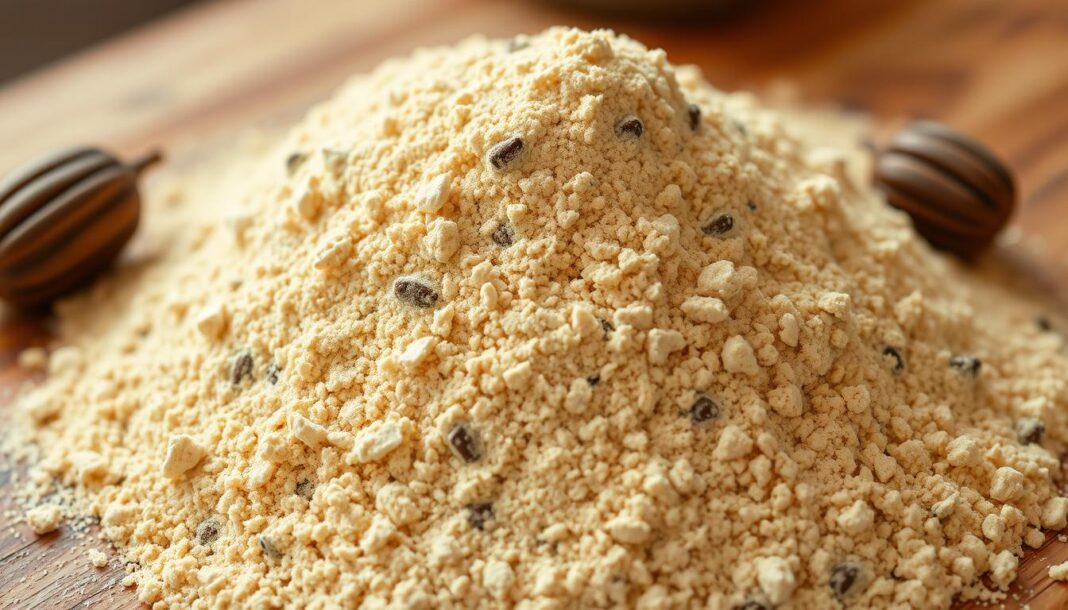For centuries, acorns have been a staple food source for many cultures, particularly among indigenous populations in North America and Europe. We explore the traditional process of transforming these acorns into a versatile ingredient.
Native Americans have long been grinding acorns into a fine flour to make hearty stews and breads, showcasing the ingredient’s culinary potential. As we delve into the world of cooking with this ancient food, you’ll discover the unique properties that make it both challenging and rewarding to work with.
At Historical Foods, we’re excited to share our comprehensive guide on working with this sustainable ingredient, from foraging to creating delicious recipes. By the end of this guide, you’ll be equipped to confidently incorporate this nutritious food into your modern cooking repertoire.
Key Takeaways
- Learn the traditional process of making acorn flour from foraging to grinding.
- Discover the unique properties and challenges of working with acorn flour.
- Explore delicious and innovative recipes using acorn flour.
- Understand the nutritional benefits and sustainability of using acorn flour.
- Get tips on how to incorporate acorn flour into your modern cooking.
What is Acorn Flour and Why Use It?
Derived from acorns, this ancient flour has been rediscovered for its nutritional benefits and culinary versatility. Acorn flour is a gluten-free alternative flour made from processed acorns that offers a unique nutty, slightly sweet flavor profile similar to chestnut flour.
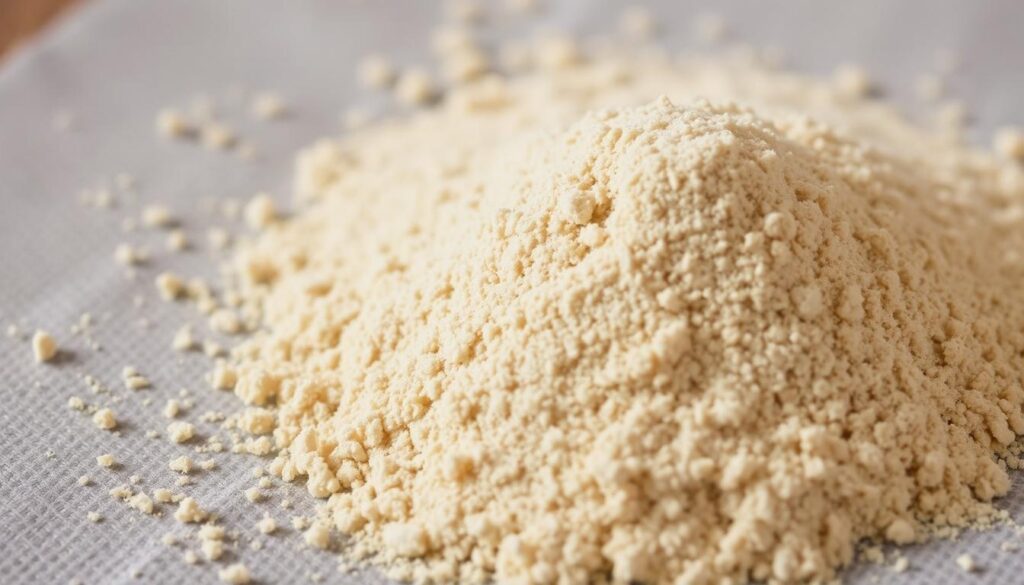
Nutritional Benefits
The nutritional profile of acorn flour varies by oak species, but it generally includes healthy fats, protein, carbohydrates, and various micronutrients, making it a nutritionally dense food source. Acorns, the primary ingredient, contain tannins that must be removed before consumption, a process perfected by indigenous peoples over generations.
- Rich in healthy fats and protein
- Contains various micronutrients
- Nutritional profile varies by oak species
Historical and Cultural Significance
Acorn flour has been a staple food across continents, from Native American tribes to European and Asian cultures. The process of acorn harvesting and processing created cultural rituals and community gatherings, strengthening social bonds in many indigenous communities. The relationship between humans and oak trees represents one of our oldest food-gathering traditions, dating back thousands of years.
By incorporating acorn flour into your diet, you’re not only benefiting from its nutritional value but also connecting with a rich cultural heritage that spans across the globe.
Foraging for Acorns: Finding the Best Varieties
With over 600 species of oak trees worldwide, finding the best acorns for flour requires knowledge and strategy. All varieties of oak produce edible acorns, but some are easier to work with than others.
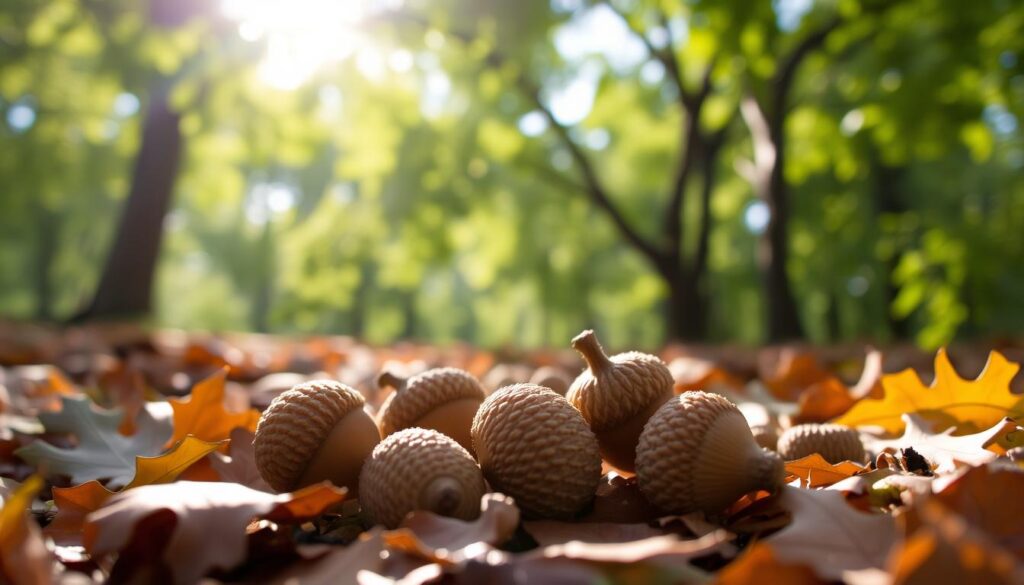
Identifying Oak Species and Their Acorns
The best acorns for flour come from white oak, burr oak, and red oak. These species are preferred due to their larger size and lower tannin content compared to others like pin oak, which are smaller and more bitter. Understanding the differences between oak species is crucial, as some, like black oak, have a thicker skin that needs to be removed before processing.
When and Where to Collect Acorns
The optimal time for collecting acorns is typically during the fall season. To determine if acorns are ready, examine their appearance and attachment to the tree. Sustainable harvesting practices are essential to ensure enough acorns are left for wildlife and forest regeneration. It’s also important to note that oak trees don’t produce consistent crops every year, following a pattern known as “mast years” with abundant production, which affects your foraging strategy. When collecting, look for acorns that have fallen to the ground and assess their quality before gathering.
For more information on using acorn flour in recipes, you can explore our guide on making delicious acorn cakes.
Preparing Acorns for Processing
The preparation of acorns is a vital step in creating high-quality acorn flour. This process involves several key steps that ensure your final product is free from contaminants and has the best possible flavor.
Sorting and Cleaning Your Harvest
To begin, sort your harvested acorns by tossing them into a bucket of water. Discard any that float, as they are likely damaged or infested with insects. This simple step in the process helps ensure you’re working with the best quality acorns.
Shelling Techniques
For shelling, you can use a nutcracker or rocks, depending on the quantity you’re processing and your preferred method. If an acorn is black or crumbles easily after cracking, it’s rotten and should be discarded. Soaking cracked acorns in water overnight can soften them, making the next steps in the process easier.
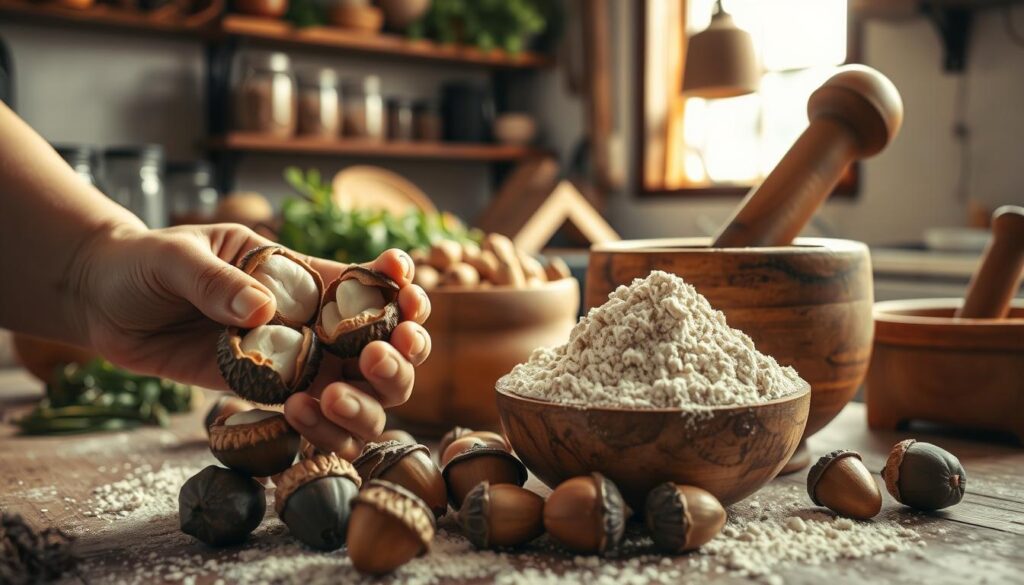
Removing the Bitter Skins
After shelling, removing the papery skin from the acorn is crucial, as it contains high concentrations of bitter tannins. Freezing fresh acorns before processing can make this task significantly easier, especially when working with larger batches. This step is essential to improve the flavor of your final flour.
| Step | Purpose | Method |
|---|---|---|
| Sorting | Remove damaged or infested acorns | Float test in water |
| Shelling | Remove shell to access nut | Nutcracker or rocks |
| Skin Removal | Remove bitter tannins | Freezing and peeling |
By following these steps and setting up an efficient acorn processing station, you can minimize time and work while maximizing the quality of your final product. Using a food processor can also streamline the grinding process later on.
Making Acorn Flour: The Complete Process
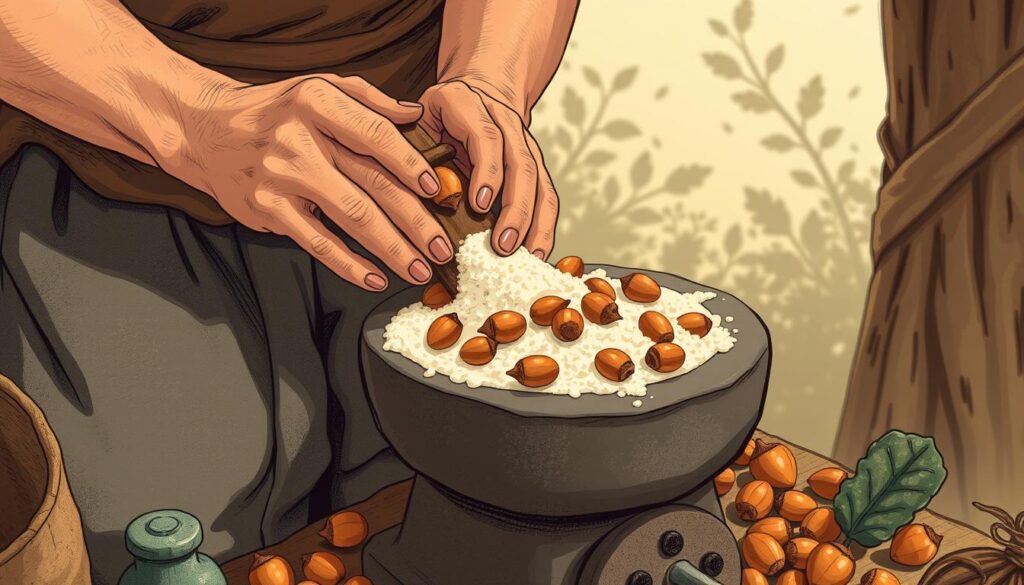
Transforming acorns into flour is a rewarding process that involves leaching, drying, and grinding. To make acorn flour, you’ll need to remove the bitter tannins from the acorns, which can be done using either the cold leaching method or the hot leaching method.
Cold Leaching Method
The cold leaching method preserves the starches in the acorns and keeps the flour lighter, but it takes several days to complete. To start, grind the acorns into a coarse meal using a food processor or coffee grinder. Then, soak the ground acorns in water, changing the water daily until the tannins are removed. This process typically takes 3-10 days, depending on the acorn variety.
During the leaching process, it’s essential to test the acorns regularly to determine when they’re ready. The acorns should taste bland rather than bitter when the tannins are fully removed. You can do this by tasting a small sample of the ground acorns.
Hot Leaching Method
The hot leaching method is faster than cold leaching, but it produces a darker flour and destroys some of the starches that help the acorn flour stick together. To use this method, soak the ground acorns in hot water, and then drain and rinse them several times until the tannins are removed. This process typically takes a few hours rather than days.
Drying and Grinding Techniques
Once the tannins have been removed, you’ll need to dry the acorn meal to create flour. You can do this using a variety of methods, including sun-drying, using a dehydrator, or drying it in a low-temperature oven. After the acorn meal is dry, you can grind it into a fine powder using a coffee grinder or specialized flour mill.
The resulting acorn flour can be used in a variety of recipes, from baked goods to savory dishes. By following these steps and choosing the right leaching method for your needs, you can create high-quality acorn flour that’s perfect for cooking and baking.
Cooking with Acorn Flour
As we explore cooking with acorn flour, we’ll discover its potential in enhancing both sweet and savory dishes. Acorn flour has a unique flavor profile that is both nutty and slightly sweet, making it an exciting addition to various recipes.
Understanding Acorn Flour’s Properties
Acorn flour is gluten-free, which affects its binding properties and requires adjustments when used in recipes that typically rely on gluten development. It is also mildly fragile, especially when made from high-fat acorns like blue oaks, live oaks, and red oaks. This characteristic demands careful handling to maintain its quality.
Substituting Acorn Flour in Recipes
To make acorn bread, for instance, you can experiment with replacing half of the bread or all-purpose flour in the recipe with acorn flour. Typically, substituting 25-50% of wheat flour with acorn flour maintains the structure while introducing the unique acorn flavor.
| Recipe Type | Acorn Flour Substitution Ratio | Resulting Flavor Profile |
|---|---|---|
| Bread | 25-50% | Nutty, slightly sweet |
| Pancakes | 20-40% | Rich, earthy |
| Thickening Agents | 100% | Deep, nutty |
Complementary Flavors and Ingredients
Balancing acorn flour‘s unique flavor with complementary ingredients and spices enhances its natural characteristics. For a delicious treat, try making a Sticky Toffee Acorn Bundt Cake, which showcases acorn flour in a sweet recipe.
By understanding the properties of acorn flour and experimenting with different recipes, you can unlock its full potential in your cooking and baking endeavors.
Delicious Recipes Using Acorn Flour
Now that we’ve explored the benefits and preparation methods of acorn flour, it’s time to dive into some delicious recipes that showcase its unique flavor and versatility. Acorn flour adds a rich, nutty taste to various dishes, making it a great addition to your culinary repertoire.
Baking with Acorn Flour Bread
Acorn bread is one of the most popular recipes to make with acorn flour. To create a delicious and hearty loaf, combine 1 cup of acorn flour with 1 cup of wheat flour, yeast, salt, and water. Mix well and bake in a preheated oven at 375°F (190°C) for about 40 minutes. The result is a flavorful bread with a dense texture.
Here’s a simple recipe to get you started:
| Ingredient | Quantity |
|---|---|
| Acorn flour | 1 cup |
| Wheat flour | 1 cup |
| Yeast | 1 tsp |
| Salt | 1 tsp |
| Water | 1 1/2 cups |
Breakfast Delights: Acorn Flour Pancakes
For a tasty breakfast, try making acorn flour pancakes. In a large bowl, combine 1 cup of white wheat flour, 1 cup of acorn flour, 2 tsp of baking powder, 1 1/2 cups of milk, and 2 eggs. Mix well and cook on a buttered pan. The result is a delicious and nutritious breakfast that’s perfect for any day of the week.
Savory Creations with Acorn Flour
Acorn flour can also be used in savory dishes, such as stews and gravies, as a thickening agent. Simply mix 1 tablespoon of acorn flour with a little water to create a slurry, then add it to your dish. You can also use acorn flour as a coating for meats before frying or baking, adding a crunchy texture and nutty flavor.
To make acorn flour cookies, combine 225g of butter, 55g of brown sugar, 1 tsp of vanilla, 1 cup of acorn flour, 1 cup of wheat flour, and spices. Bake in a preheated oven at 170°C (338°F) for 12-15 minutes. The result is a delicious treat that’s perfect for snacking.
Storing and Preserving Your Acorn Flour
Acorn flour, due to its high fat content, requires careful storage to prevent rancidity. This is particularly true for flours made from acorns of certain oak species like blue oaks, live oaks, and red oaks, which have higher fat contents compared to white oaks.
To extend the shelf life of your acorn flour, store it in airtight glass jars, such as quart Mason jars, in cool, dark places like the refrigerator or freezer. This method can help preserve the flour for several years, which is fortunate since oak trees do not produce abundant acorns every year.
When stored properly, you can enjoy your acorn flour throughout the year. Regularly check your stored flour for any signs of rancidity by smell and taste. By putting in the time and effort to make and store acorn flour, you not only preserve a traditional food source but also deepen your connection with the natural world.
